
Have you ever felt like your regular walking routine just isn’t delivering the weight loss results you’ve been hoping for? I’ve been there too, watching the scale barely budge despite logging miles every day! Interval walking might be the game-changing approach you need to finally start seeing real progress. Unlike traditional steady-pace walking, interval walking strategically alternates between periods of high and low intensity, creating a metabolic sweet spot that transforms your body into a fat-burning machine.
I discovered interval walking when my own fitness journey hit a plateau, and let me tell you, the difference was night and day. This approach doesn’t just burn more calories during your workout—it continues torching fat long after you’ve finished walking. The science behind it is fascinating: by pushing your body through these intensity shifts, you’re triggering powerful hormonal responses that target stubborn fat stores while preserving lean muscle. Whether you’re just starting your weight loss journey or looking to break through a frustrating plateau, interval walking offers a sustainable, joint-friendly path to reaching your goals faster than you might have thought possible.
This post may contain affiliate links. I only recommend products and services I genuinely believe in. Additionally, some images on this website may have been created with the help of AI to convey the feeling I wish to share with the reader.
What You Might Need
- Comfortable, supportive walking shoes with good cushioning
- Moisture-wicking clothing appropriate for your climate
- Water bottle for hydration during your workout
- Fitness tracker or smartphone app to monitor intervals
- Heart rate monitor (optional but helpful)
- Interval timer app or stopwatch
- Proper sun protection (hat, sunglasses, sunscreen)
- Reflective gear if walking during low-light conditions
What Is Interval Walking and Why It Works for Weight Loss

Walking has always been my go-to exercise whenever life gets hectic, but when I discovered interval walking, everything changed about my results. The concept is beautifully simple yet incredibly effective: alternate between periods of faster, more intense walking and recovery periods at a more relaxed pace. This constant shifting of gears keeps your body guessing and prevents the dreaded efficiency plateau that happens when you do the same exercise day after day.
What makes interval walking so special for weight loss specifically is how it affects your metabolism at a cellular level. Unlike steady-state cardio where your body quickly adapts and learns to conserve energy, interval training creates something called “metabolic disruption”—a positive stress that forces your body to work harder to return to homeostasis. This process burns significantly more calories both during and after your workout, with studies showing that the afterburn effect (officially called EPOC—Excess Post-exercise Oxygen Consumption) can continue elevating your metabolism for up to 24-48 hours afterward!
The Science of Metabolic Disruption
Interval walking creates short oxygen deficits in your muscles, triggering hormonal changes that signal your body to burn stored fat for fuel.
Beyond Calorie Burning
Unlike steady-state walking, intervals preserve lean muscle mass while targeting fat stores, creating a more toned appearance as you lose weight.
Efficiency Factor
A 30-minute interval walking session can burn significantly more calories than a 60-minute steady-paced walk, making it perfect for busy schedules.
How to Design Your First Interval Session
- Start with a proper 5-minute warm-up at an easy pace to prepare your muscles and joints
- Begin with a 1:2 ratio (30 seconds of brisk walking followed by 60 seconds of recovery walking)
- Aim for perceived effort rather than specific speeds – your “fast” interval should feel challenging but sustainable
- Complete 6-8 intervals for your first few sessions before gradually increasing
- Always finish with a 5-minute cooldown to gradually bring your heart rate back to normal
Picture This
You’re walking through your neighborhood as the morning sun filters through the trees. During your high-intensity intervals, you’re moving with purpose—arms pumping, breath quickening, feeling the energy surge through your body. Then, as you shift to your recovery interval, you settle into a gentler rhythm, feeling your breathing normalize as you prepare for the next push. With each interval walking session, you’re not just covering distance—you’re strategically reshaping your metabolism, burning fat long after your shoes come off.
The Science Behind Interval Walking for Fat Loss
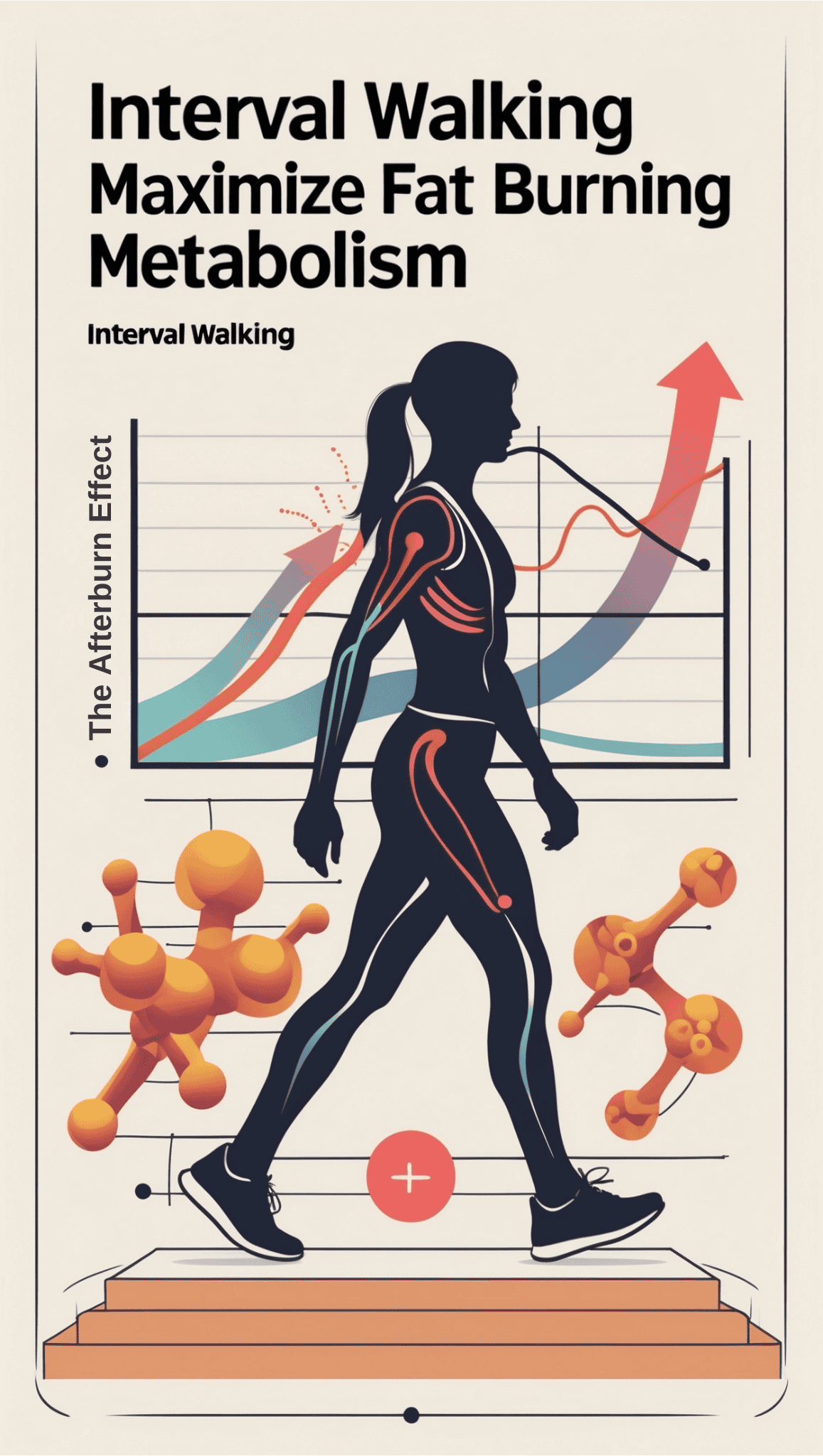
The first time I explained interval walking to a friend, her eyes glazed over at the mention of “metabolic conditioning.” But here’s the simple truth: your body is incredibly adaptive, which is both amazing and frustrating when you’re trying to lose weight. When you walk at the same pace every day, your metabolism essentially learns to become more fuel-efficient—meaning you burn fewer calories over time doing the exact same exercise. Interval walking disrupts this adaptation by constantly challenging your system with varying intensities.
What happens physiologically during interval walking is fascinating. During high-intensity intervals, your body primarily uses carbohydrates for quick energy, but the magic happens during the recovery periods when your body shifts to burning fat while simultaneously replenishing energy stores for the next interval. This metabolic toggling creates a powerful effect that conventional steady-state walking simply cannot match. Research published in the Journal of Applied Physiology found that interval training can increase fat oxidation rates by up to 36% compared to moderate continuous exercise—meaning your body literally becomes better at using fat as fuel!
Hormonal Advantage
Interval walking triggers a greater release of fat-burning hormones like epinephrine and growth hormone compared to steady-state exercise.
Insulin Sensitivity Enhancement
Regular interval training improves your cells’ response to insulin, making it easier for your body to manage blood sugar and store less fat.
Mitochondrial Development
Your cells’ “power plants” (mitochondria) increase in number and efficiency with interval training, enhancing your metabolic rate even at rest.
How to Maximize the Scientific Benefits
- Monitor your heart rate to ensure you’re reaching 70-85% of your maximum during high-intensity intervals
- Keep recovery periods active but genuinely restorative (around 50-60% of max heart rate)
- Time your interval sessions strategically – preferably in a fasted state in the morning or 2-3 hours after a meal
- Stay consistent with 3-4 sessions per week to maintain the metabolic adaptations
- Gradually increase intensity rather than duration as your fitness improves
Picture This
Your body is like a sophisticated engine that’s being fine-tuned with each interval walking session. During those moments when you push to a challenging pace, you’re signaling thousands of biochemical reactions: your muscle cells are developing more mitochondria, your hormonal system is optimizing fat-burning signals, and your cardiovascular system is becoming more efficient. As you toggle between high and low-intensity intervals, you’re essentially “teaching” your metabolism to become more flexible and responsive, creating lasting changes that continue burning calories long after your interval walking session has ended.
Getting Started: Essential Equipment for Interval Walking
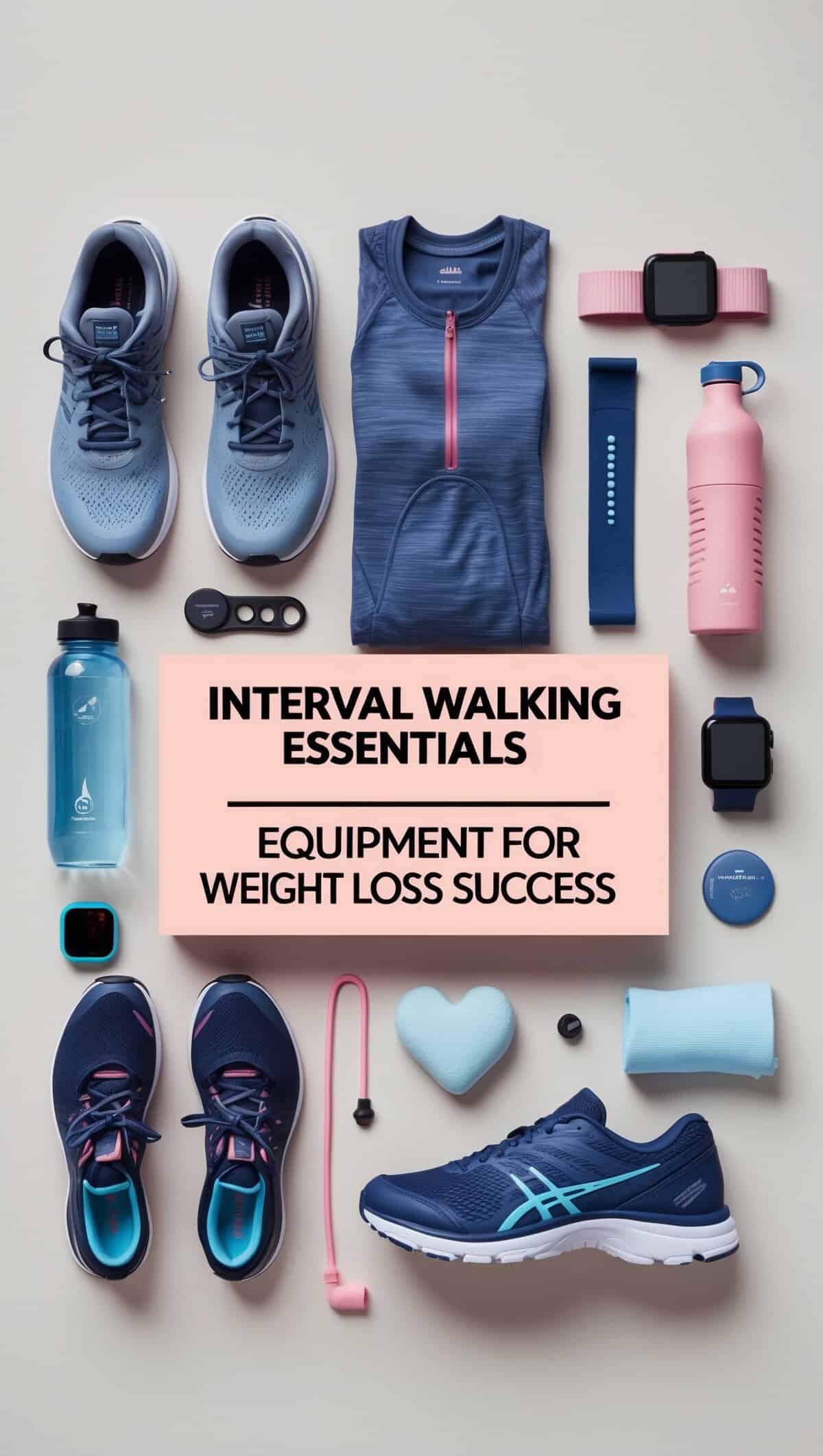
When I first began my interval walking journey, I made the mistake of using my old, worn-out sneakers and immediately regretted it! The right equipment doesn’t need to be expensive, but it can make the difference between an effective, enjoyable experience and an uncomfortable or even injury-prone one. Proper footwear is absolutely your foundation—look for walking shoes with good arch support, cushioning, and flexibility in the forefoot, as interval walking puts different stresses on your feet than steady-state walking.
Beyond shoes, comfort and functionality should guide your choices for the rest. Moisture-wicking clothing helps prevent chafing and keeps you comfortable through the more intense intervals when you’ll inevitably sweat more. While not essential, a reliable way to time your intervals is tremendously helpful—whether that’s a dedicated interval timer app, a fitness watch, or even just the timer on your phone. I personally found that having audible cues to signal interval changes allows me to focus on my form and breathing rather than constantly checking the time.
Smart Tracking Tools
A fitness tracker with heart rate monitoring capabilities can help you quantify your effort and progress over time.
Weather-Appropriate Gear
Different climate conditions require specific clothing considerations—layering options for cold weather and breathable, sun-protective gear for heat.
Tech-Free Alternatives
Simple tools like a printed interval plan or landmarks along your route can work just as effectively as digital timers for interval management.
How to Choose the Right Equipment
- Invest in proper walking shoes first – visit a specialty store for gait analysis if possible
- Select clothing that won’t distract you with chafing, riding up, or overheating
- Test interval timing methods to find what works best for your style (audible alerts, vibrations, or visual cues)
- Start simple and add equipment only as you determine what would genuinely enhance your experience
- Consider terrain-specific gear if you’ll be interval walking on trails, inclines, or varying surfaces
Picture This
You’re lacing up your perfectly fitted walking shoes, dressed in comfortable layers that move with your body. Your interval timer is set and ready to guide you through the workout with gentle alerts. As you begin your interval walking session, each piece of carefully selected equipment serves its purpose seamlessly—supporting your body’s movements, helping you track your effort, and keeping you comfortable through changing intensities. With the right tools supporting your interval walking practice, you’re able to focus entirely on the rhythm of your movement and the transformative experience of pushing your limits during those high-intensity intervals.
Beginner’s Interval Walking Plan for Weight Loss
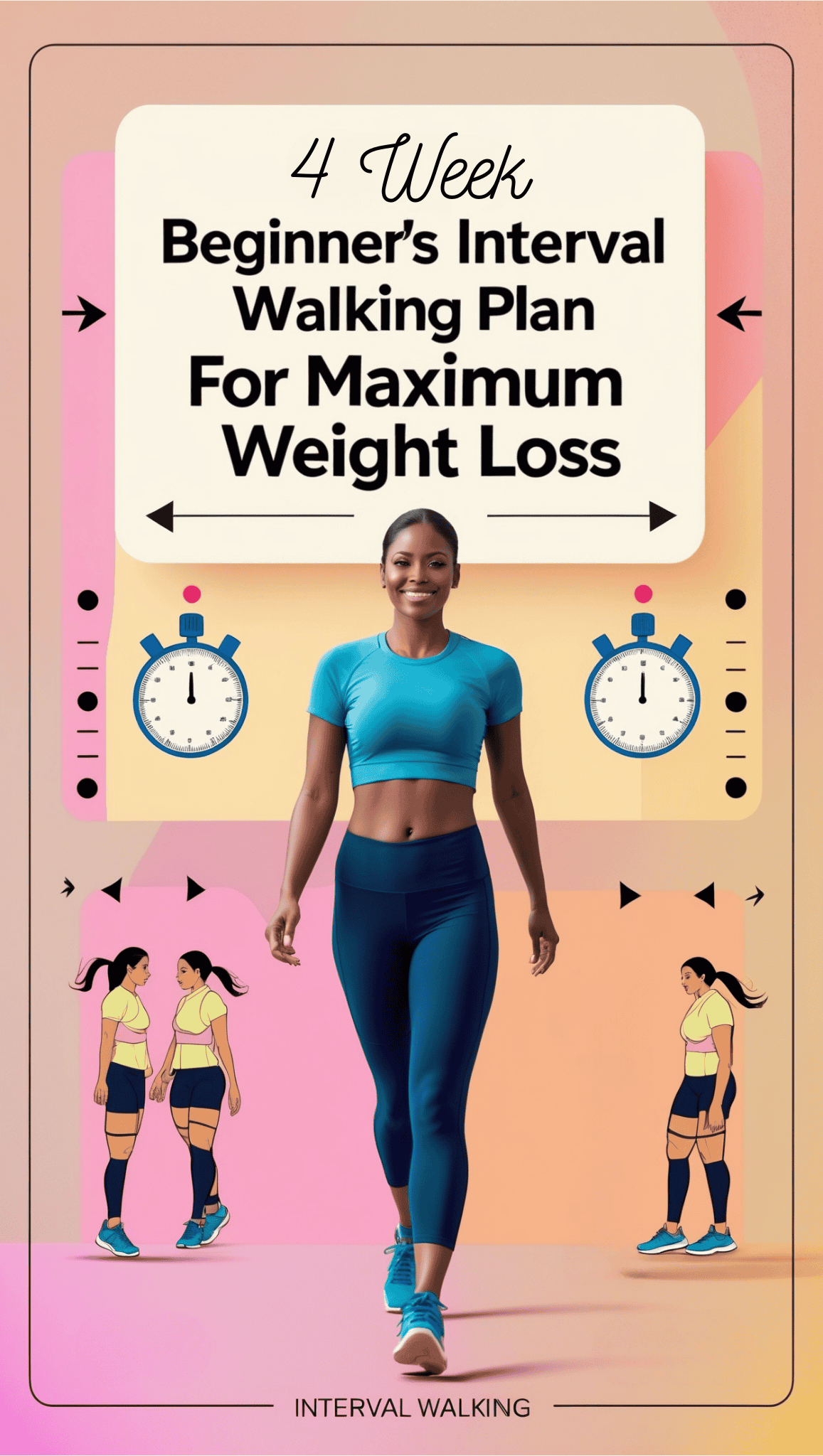
When I first tried interval walking, I made the classic mistake of going too hard too soon and nearly gave up before experiencing the amazing benefits! The key for beginners is gradual progression—your body needs time to adapt to this new style of training. Start with a ratio that feels challenging but manageable, like 30 seconds of faster walking followed by 90 seconds of recovery walking. This 1:3 work-to-rest ratio gives your body plenty of time to recover between efforts while still providing enough stimulus for positive adaptations.
What I love about interval walking for beginners is that you can define “high intensity” based on your current fitness level. If you’re just starting out, your high-intensity interval might simply be a brisk walk where you can still speak in short sentences, while your recovery interval is a comfortable stroll. The relative difference between your intervals matters more than absolute speed. Aim to complete two interval walking sessions per week initially, gradually building to three or four sessions as your body adapts and your recovery improves.
Building Consistency First
Focus on establishing a regular interval walking habit before worrying about increasing intensity or duration.
Form Fundamentals
Proper walking posture—with shoulders relaxed, core engaged, and arms swinging naturally—maximizes benefits and prevents injury.
Recovery Recognition
Learning to value and properly execute recovery intervals is just as important as pushing during high-intensity periods.
How to Structure Your First Month
- Week 1: Complete 2 sessions with 6 intervals of 30 seconds high intensity/90 seconds recovery
- Week 2: Complete 2-3 sessions with 8 intervals of 30 seconds high intensity/90 seconds recovery
- Week 3: Complete 3 sessions with 8 intervals of 40 seconds high intensity/80 seconds recovery
- Week 4: Complete 3 sessions with 10 intervals of 40 seconds high intensity/80 seconds recovery
- Always include 5-minute warm-up and cooldown periods before and after your interval sets
Picture This
It’s a crisp morning as you begin your beginner’s interval walking routine. During your high-intensity intervals, you pick up the pace just enough to feel your breathing deepen and your muscles engage more actively. Your recovery periods feel genuinely refreshing, giving you time to prepare mentally for the next push. With each session, you notice subtle improvements—what felt challenging last week feels more manageable today. Your interval walking practice is building not just physical strength but also mental confidence as you prove to yourself that you can sustain this effective approach to weight loss.
Intermediate Interval Walking Workouts
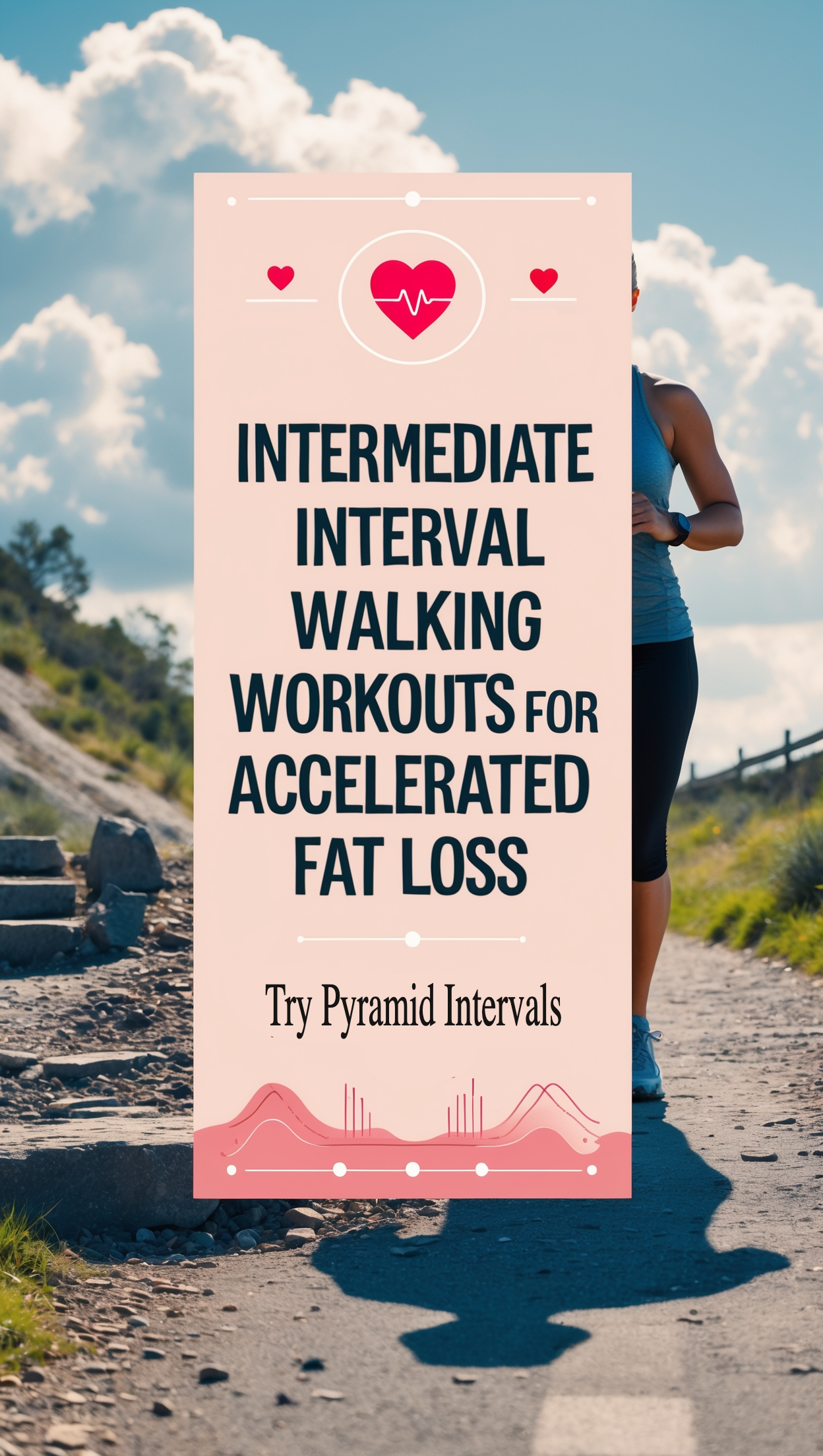
After a few weeks of consistent beginner interval walking, I noticed something amazing—what once felt challenging had become surprisingly manageable! This is exactly when you should consider advancing to intermediate interval workouts to continue seeing weight loss results. At this level, we can start playing with the work-to-rest ratio, gradually shifting from the beginner’s 1:3 ratio toward a more challenging 1:2 or even 1:1 ratio. This doesn’t necessarily mean longer high-intensity intervals; instead, it often means shorter recovery periods that keep your heart rate elevated.
What makes intermediate interval walking particularly effective for weight loss is the introduction of variability. Rather than doing the same interval pattern every session, try alternating between different types of workouts throughout your week. One day might focus on longer intervals (60-90 seconds) with equal recovery periods, while another session might feature short, intense bursts (30-45 seconds) with minimal recovery. This variability prevents adaptation and keeps your metabolism guessing, which is the secret sauce for continued progress when regular walking has stopped working.
Intensity Progression
Learn to use the “talk test” to gauge your intensity—during high intervals, you should be able to speak only in short phrases.
Terrain Tactics
Incorporating hills, stairs, or inclines during high-intensity intervals naturally increases challenge without requiring faster movement.
Recovery Refinement
Intermediate walkers should focus on active recovery—maintaining good posture and purposeful movement even during lower-intensity periods.
How to Structure an Intermediate Program
- Try “pyramid” intervals (30sec/45sec/60sec/45sec/30sec of high intensity with consistent recovery periods)
- Incorporate “fartlek” training by using landmarks to determine irregular interval patterns
- Add one longer interval session per week (4-6 intervals of 2-3 minutes with equal recovery)
- Include one shorter, more intense session (8-10 intervals of 30 seconds with 30-45 seconds recovery)
- Listen to your body and adjust intensity based on daily energy levels and recovery status
Picture This
You’re confidently striding along your favorite park path, seamlessly transitioning between your work and recovery intervals. During high-intensity periods, you’re moving with purpose and power, feeling your heart rate climb and your muscles fully engage. Your recovery intervals are shorter now, but you’ve learned to make them count—breathing rhythmically and maintaining good form while preparing for the next push. Your interval walking practice has evolved into a sophisticated training approach that continuously challenges your body’s metabolic systems, creating the optimal environment for ongoing weight loss results.
Advanced Interval Walking Protocols for Maximum Fat Loss
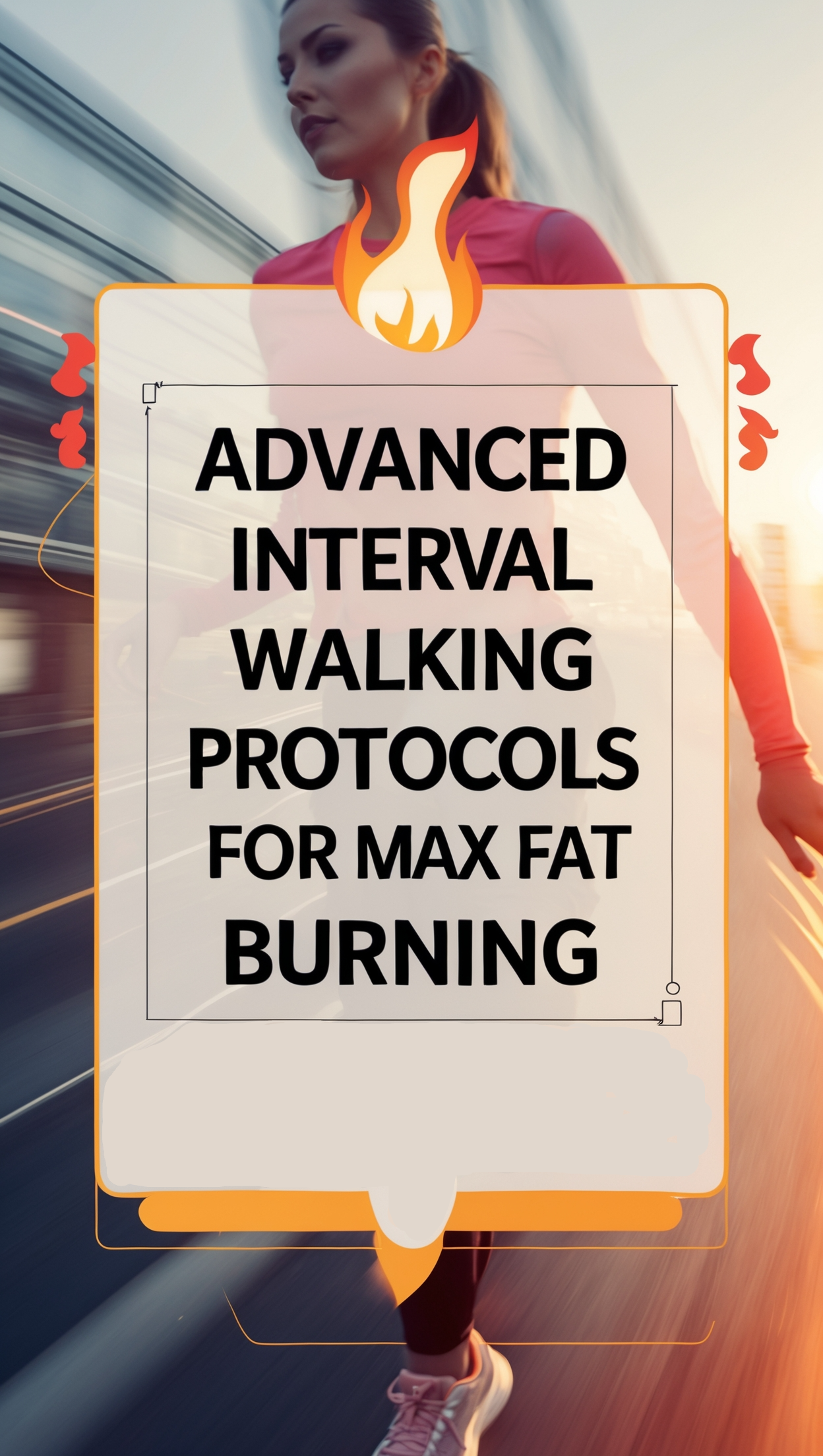
When my clients reach the advanced interval walking stage, that’s when the truly transformative fat loss results typically appear! At this level, we’re no longer just walking faster or longer—we’re strategically manipulating multiple variables to create precisely targeted metabolic effects. Advanced interval walking incorporates near-maximal effort periods (think power walking at a pace where talking becomes quite difficult) alternated with very short recovery periods. This approach maximizes EPOC (that valuable afterburn effect) and creates significant metabolic disruption.
What distinguishes advanced protocols is their precision and periodization. Rather than randomly increasing intensity, advanced interval walkers follow structured programs that systematically vary the work-to-rest ratios, intensities, and session frequencies throughout a training cycle. This methodical approach prevents plateaus while minimizing injury risk. One particularly effective advanced technique is “descending recovery” intervals, where each recovery period in a set becomes progressively shorter (e.g., 60, 45, 30, 15 seconds) while maintaining consistent high-intensity intervals—creating cumulative fatigue that amplifies the fat-burning response.
Metabolic Maximizers
Advanced interval patterns like Tabata (20 seconds high/10 seconds low) or HIIT (30 seconds high/30 seconds low) create optimal hormonal responses.
Progressive Overload Principles
Systematically increasing intensity, decreasing recovery, or adding resistance ensures continued adaptation and fat loss results.
Recovery Enhancement
Advanced interval walkers need sophisticated recovery practices between sessions, including proper nutrition, sleep optimization, and stress management.
How to Structure Advanced Interval Sessions
- Incorporate “EMOM” (Every Minute On the Minute) intervals with 40-45 seconds of high intensity followed by whatever time remains in the minute for recovery
- Try “descending ladder” workouts (60/60, 50/50, 40/40, 30/30, 20/20 seconds work/rest)
- Add resistance with weighted vests, hills, or stairs during high-intensity intervals
- Experiment with “sprint finish” sessions where the final interval of each set is performed at maximum effort
- Follow a periodized approach with dedicated harder and easier weeks to optimize recovery and adaptation
Picture This
It’s dawn and you’re executing an advanced interval walking session with precision and intensity. During your high-intensity intervals, you’re driving forward with powerful strides, arms pumping rhythmically, heart rate climbing to near 85% of your maximum. Your recovery periods are brief yet effective—just enough time to regulate your breathing before the next surge of effort. With each expertly crafted interval walking session, you’re creating the perfect metabolic environment for maximum fat oxidation. Your body has become a highly responsive fat-burning system, efficiently mobilizing and utilizing stored fat not just during your workout but throughout your day.
Nutrition Strategies to Enhance Interval Walking Results
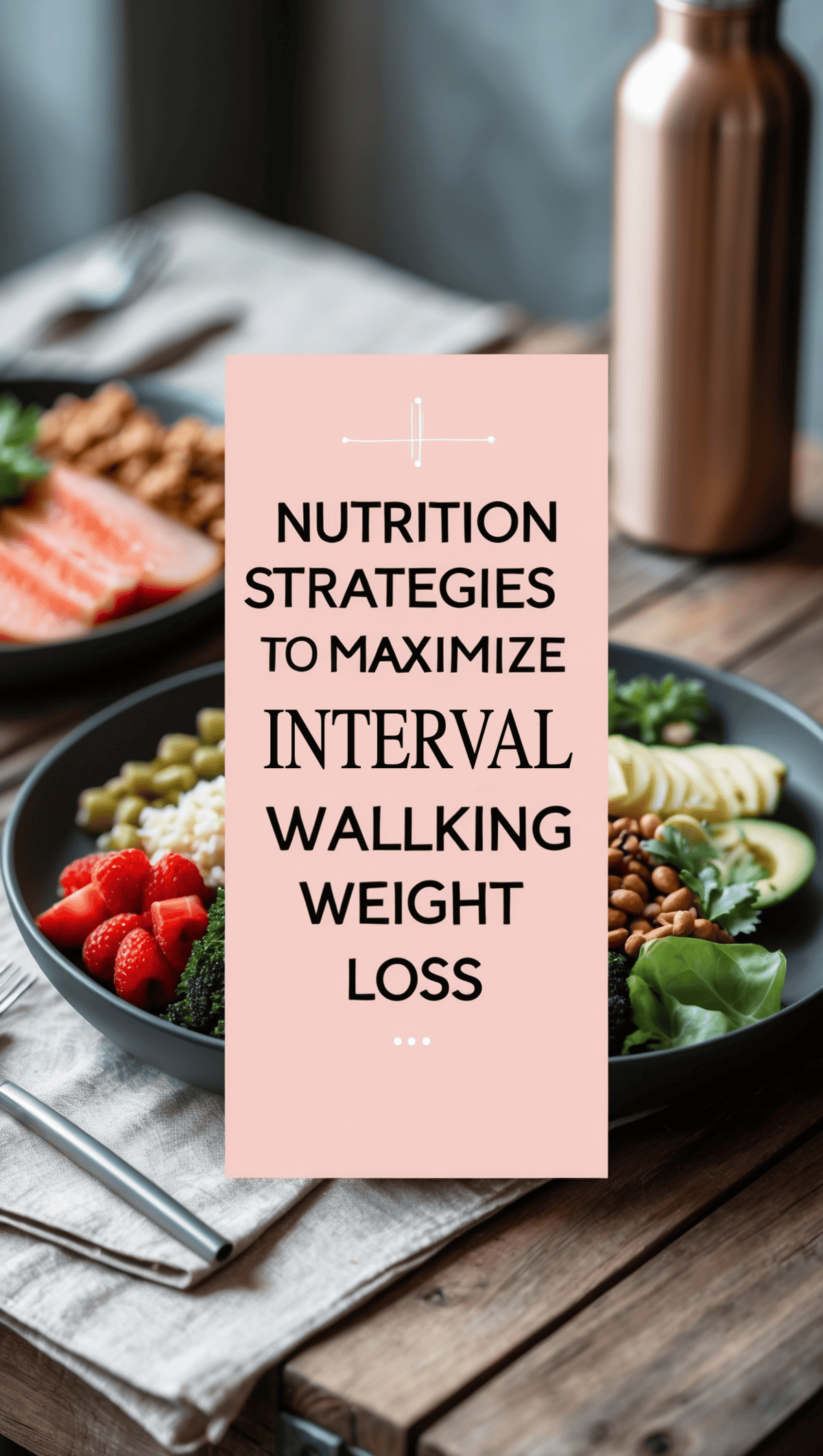
When I finally aligned my eating habits with my interval walking routine, my weight loss results literally doubled in speed! Nutrition and exercise work synergistically when properly matched, creating a metabolic environment that’s primed for fat loss. The timing of your meals relative to your interval walking sessions can significantly impact both performance and results. For morning interval walkers, a light protein-carb combination about 30-45 minutes before your session (like half a banana with a tablespoon of almond butter) can provide accessible energy without weighing you down.
What many people don’t realize is that post-workout nutrition is where the magic happens for weight loss. The 30-60 minute window after your interval walking session is when your body is most receptive to nutrients, particularly protein and fast-absorbing carbohydrates. This “metabolic window” isn’t just bro-science—research confirms that proper post-exercise nutrition enhances recovery, supports muscle maintenance, and helps regulate the hormones that control appetite and fat storage. I recommend a recovery meal with a 2:1 carb-to-protein ratio, focusing on whole food sources like a smoothie with fruit, Greek yogurt, and a handful of spinach.
Strategic Meal Timing
Scheduling larger meals earlier in the day and lighter meals in the evening can align with your body’s natural metabolic rhythm.
Hydration Connection
Proper fluid balance is essential for optimal fat metabolism, with research showing even mild dehydration can reduce fat oxidation rates.
Protein Prioritization
Maintaining adequate protein intake (approximately 0.7-1g per pound of ideal body weight) preserves muscle mass during weight loss.
How to Optimize Your Nutrition Plan
- Consider fasted morning interval walking (if comfortable) to potentially enhance fat oxidation
- Hydrate properly before, during, and after with plain water for sessions under 60 minutes
- Consume a recovery meal or shake within 45 minutes after completing your interval session
- Focus on whole, minimally processed foods that support hormonal balance and reduce inflammation
- Monitor your hunger signals and adjust meal timing around your interval walking schedule for optimal energy
Picture This
You’ve just completed an invigorating interval walking session, your body energized and responsive. With thoughtful planning, your nutrition perfectly complements your exercise efforts—a balanced post-workout meal awaits, timed to capitalize on your body’s enhanced nutrient sensitivity. Throughout your day, well-timed, nutrient-dense meals and snacks maintain stable energy and support recovery. Your hydration is on point, supporting every metabolic process. This harmonious relationship between your interval walking practice and nutrition creates a powerful synergy, accelerating fat loss and enhancing your overall well-being in ways that neither strategy alone could achieve.
Overcoming Plateaus: How to Keep Losing Weight with Interval Walking
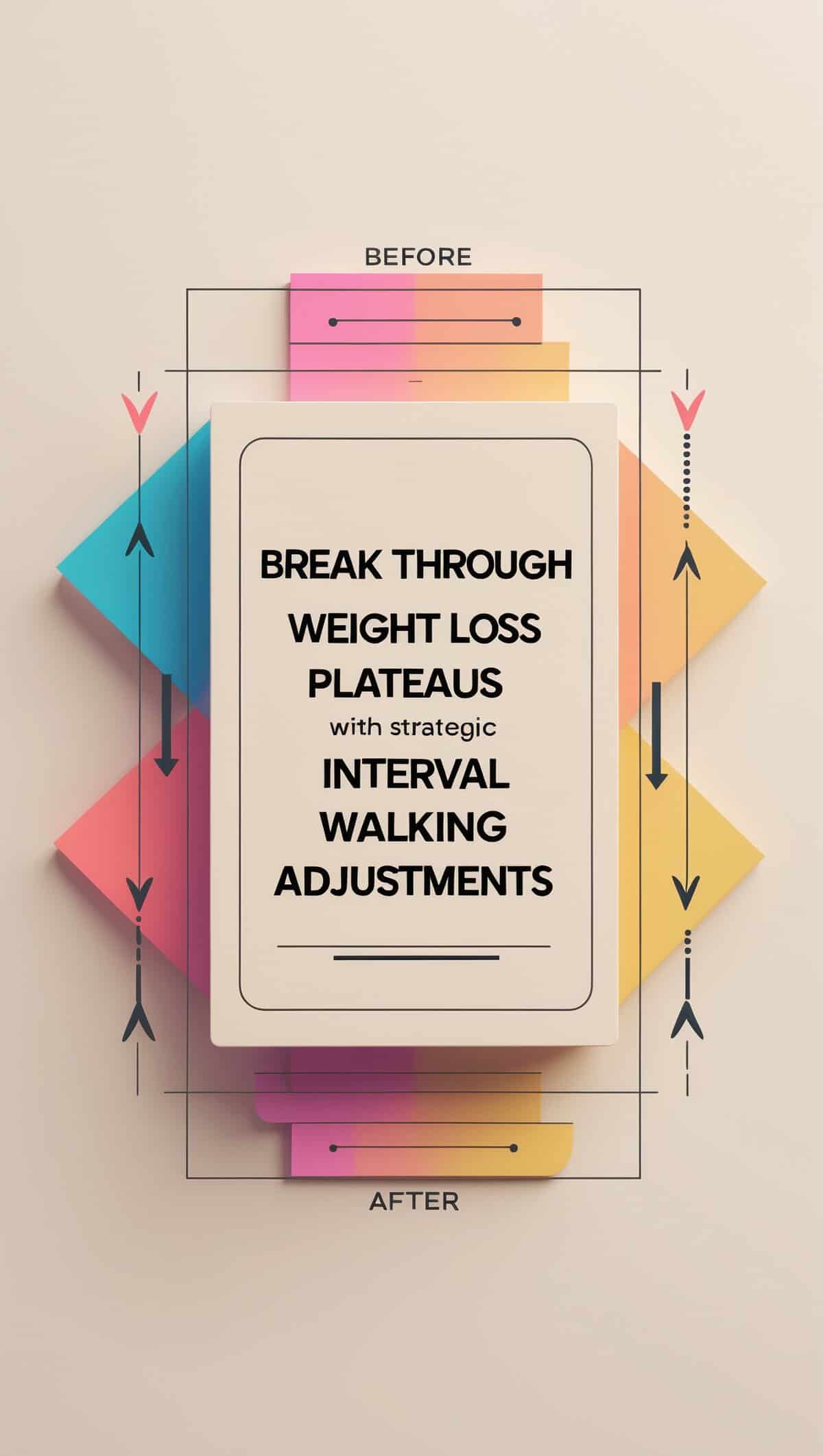
I’ll never forget the frustration of hitting my first major weight loss plateau despite faithfully continuing my interval walking routine! Weight loss plateaus are not only normal but actually a sign that your program has been working—your body has adapted to the demands you’ve been placing on it and has established a new equilibrium. The key to breaking through plateaus is recognizing them early and implementing strategic changes before frustration sets in. Look for signs like unchanged measurements for 2-3 weeks, decreased perceived exertion during workouts, or feeling less hungry post-exercise.
The most effective plateau-busting approach combines multiple small changes rather than one dramatic shift. First, examine your interval ratios and consider decreasing recovery periods while maintaining the same high-intensity duration. Next, look at your overall training structure—perhaps it’s time to incorporate variable intensity days throughout your week rather than doing the same interval pattern consistently. Finally, honestly reassess your nutrition habits, which often unconsciously shift over time. Small increases in portion sizes or subtle changes in food choices can create enough of a caloric surplus to halt weight loss progress, even with a consistent interval walking routine.
Intensity Variables
Manipulating speed, incline, arm movements, or resistance can re-challenge your body when simple intervals no longer produce results.
Session Structure Shifts
Changing the number, duration, or pattern of intervals introduces novel stimulus that can restart progress.
Cross-Training Complements
Temporarily incorporating different exercise modalities alongside interval walking can overcome adaptation and engage new muscle groups.
How to Break Through a Plateau
- Try “shock” sessions with dramatically different interval patterns once weekly
- Incorporate backward walking or side-stepping during recovery intervals for muscular balance
- Add one longer, steady-state session per week to build aerobic base and support recovery
- Implement a “deload” week with reduced intensity before returning to more challenging intervals
- Track metrics beyond weight (measurements, energy levels, sleep quality) to recognize progress in different forms
Picture This
You’re walking with renewed purpose after intelligently adjusting your interval walking routine to overcome a plateau. The strategic changes you’ve implemented—perhaps steeper inclines during high-intensity intervals or a completely restructured interval pattern—are challenging your body in novel ways. You notice your breathing is deeper, your muscles are working differently, and that energized post-workout feeling has returned in full force. This evolution in your interval walking practice demonstrates your growing fitness sophistication, as you’re no longer following a one-size-fits-all approach but rather listening to your body and making precise adjustments that continue to deliver weight loss results.
Tracking Progress: Metrics Beyond the Scale
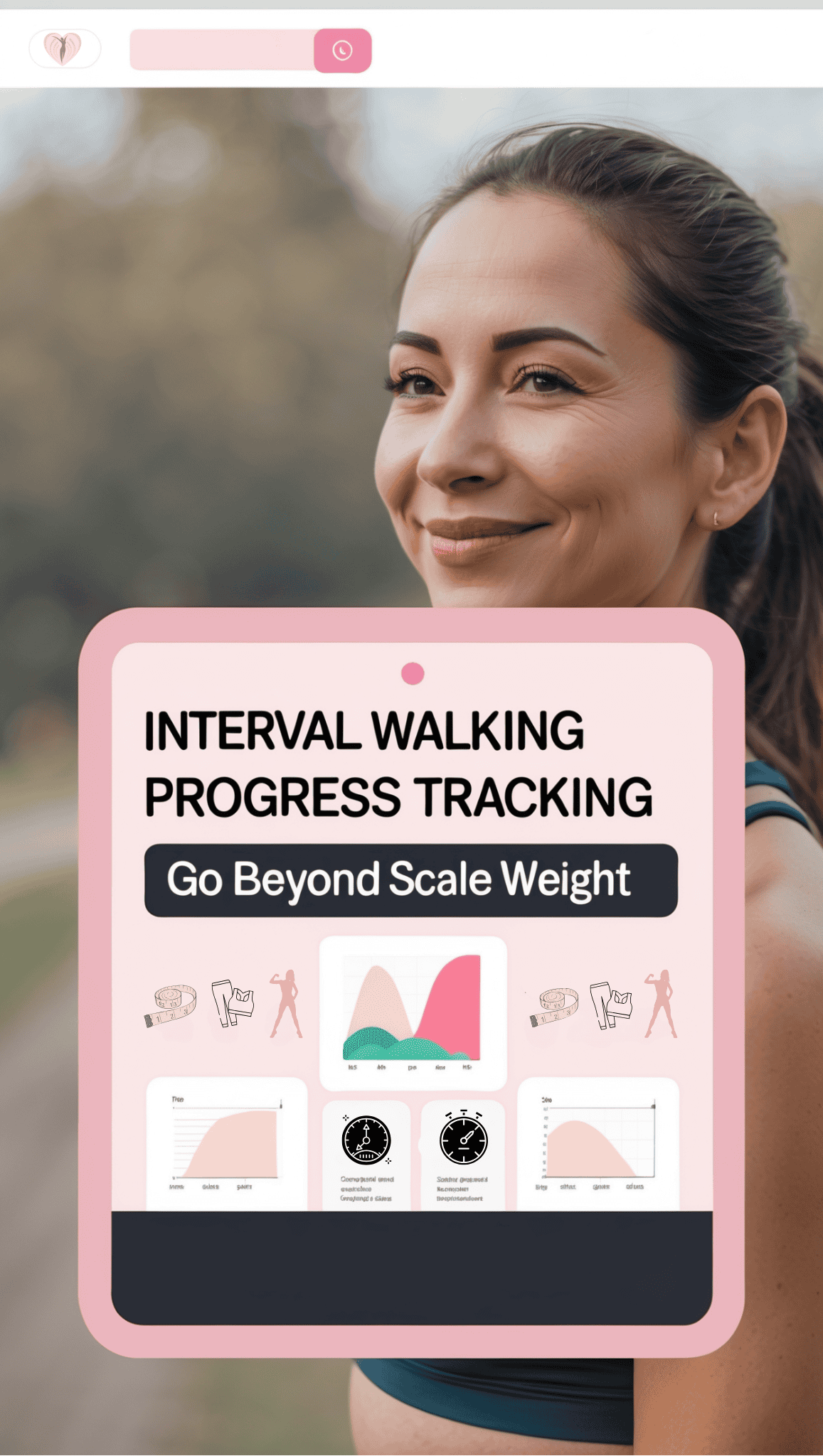
When working with clients new to interval walking for weight loss, I frequently observe their obsession with checking the scale every morning! It typically takes weeks to help them realize this approach actually undermines motivation and progress. The scale is notoriously unreliable as a short-term progress indicator due to water retention, hormonal fluctuations, and muscle adaptations—all of which can mask fat loss. A much more reliable approach is tracking a diverse set of metrics that collectively tell the true story of the body’s transformation through interval walking.
Body measurements provide objective data that often reveals progress when the scale hasn’t budged. I recommend clients take measurements of their chest, waist, hips, thighs, and upper arms every 2-3 weeks rather than weekly, as changes tend to be more noticeable over longer intervals. Beyond physical measurements, performance metrics offer powerful insight into improving fitness—tracking how many intervals can be completed, recovery heart rate one minute after high-intensity intervals, or how quickly one can walk a set distance. These fitness improvements correlate strongly with positive metabolic changes that support weight loss, even when they temporarily precede changes in body composition.
Biomarker Benefits
For those with access, metrics like resting heart rate, blood pressure, and bloodwork results often improve before significant weight loss appears.
Subjective Signposts
Energy levels, sleep quality, mood stability, and clothing fit can provide valuable feedback about your progress beyond objective measurements.
Visual Verification
Weekly or bi-weekly progress photos taken under consistent conditions often reveal changes that measurements miss.
How to Create a Comprehensive Tracking System
- Establish a consistent measurement routine with the same time of day, body positions, and measurement locations
- Record workout performance metrics like interval speeds, perceived exertion, and recovery heart rates
- Use a simple journal to track energy levels and hunger patterns throughout the day
- Take progress photos in consistent lighting and poses from multiple angles (front, side, back)
- Consider technology like bioimpedance scales that estimate body composition changes over time
Picture This
You’re reviewing your interval walking progress journal, noticing the compelling story it tells beyond mere weight numbers. The pages reveal how your recovery heart rate has steadily decreased over weeks, how your walking pace during high-intensity intervals has naturally increased, and how your energy levels have stabilized throughout the day. The measurements show subtle yet consistent changes in your waist and thigh circumference. Most importantly, your journal entries reflect an evolving relationship with interval walking—what began as purely a weight loss method has become a practice you genuinely enjoy for how it makes you feel strong, capable, and energized.
Success Stories: Real People Who Lost Weight with Interval Walking

Maria’s transformation began after her doctor warned her about prediabetes and recommended daily walking. “I was walking 30 minutes every day for weeks with minimal results, until my neighbor suggested interval walking,” she recalls. What started as simple 30-second bursts of faster walking completely revolutionized her results. Within three months of consistent interval walking (just 4 sessions weekly), Maria had lost 22 pounds and normalized her blood sugar levels. More importantly, she discovered a sustainable approach that didn’t feel like punishment—”During those high-intensity intervals, I feel powerful rather than tired, and I love that the workout is constantly changing.”
Robert’s story particularly resonates with me because, like many, he had been an athlete in his younger years but found himself 45 pounds overweight at age 52. Traditional gym workouts aggravated his knee issues, but interval walking provided a joint-friendly alternative that still delivered intensity. “The progressive nature of interval walking allowed me to start gently but consistently increase the challenge,” he explains. Robert combined a structured interval walking program with basic nutrition changes, ultimately losing 37 pounds over 7 months while significantly improving his cholesterol profile. His advice? “Trust the process and be patient—my biggest results came after the first two months when my body had fully adapted to the interval approach.”
Consistency Champions
Successful interval walkers prioritize adherence over perfection, focusing on showing up consistently rather than executing the “perfect” workout.
Adaptation Awareness
Those who achieved significant weight loss embraced the need to progressively modify their interval protocols as their fitness improved.
Holistic Approach
The most dramatic transformations combined interval walking with basic nutrition improvements and stress management strategies.
How to Apply Success Principles to Your Journey
- Document your “why” and keep it visible for motivation during challenging periods
- Establish clear, measurable process goals (like completing 3 interval sessions weekly) rather than focusing solely on outcome goals
- Create accountability systems through walking partners, online communities, or regular check-ins
- Celebrate non-scale victories like improved energy, better sleep, or increased walking speed
- Plan for obstacles in advance with specific strategies for weather changes, schedule disruptions, or motivation dips
Picture This
You’re joining the ranks of successful interval walkers who have transformed their bodies and health. Like Maria and Robert, you’ve discovered that the strategic alternation between challenging and recovery periods creates a sustainable approach to weight loss that conventional walking simply can’t match. Each interval session builds your confidence along with your fitness, creating positive momentum that carries into other health choices. Your interval walking practice has evolved from something you “should do” for weight loss into something you genuinely look forward to—a keystone habit that continues delivering results long after other approaches have failed.
Common Mistakes to Avoid for Optimal Results
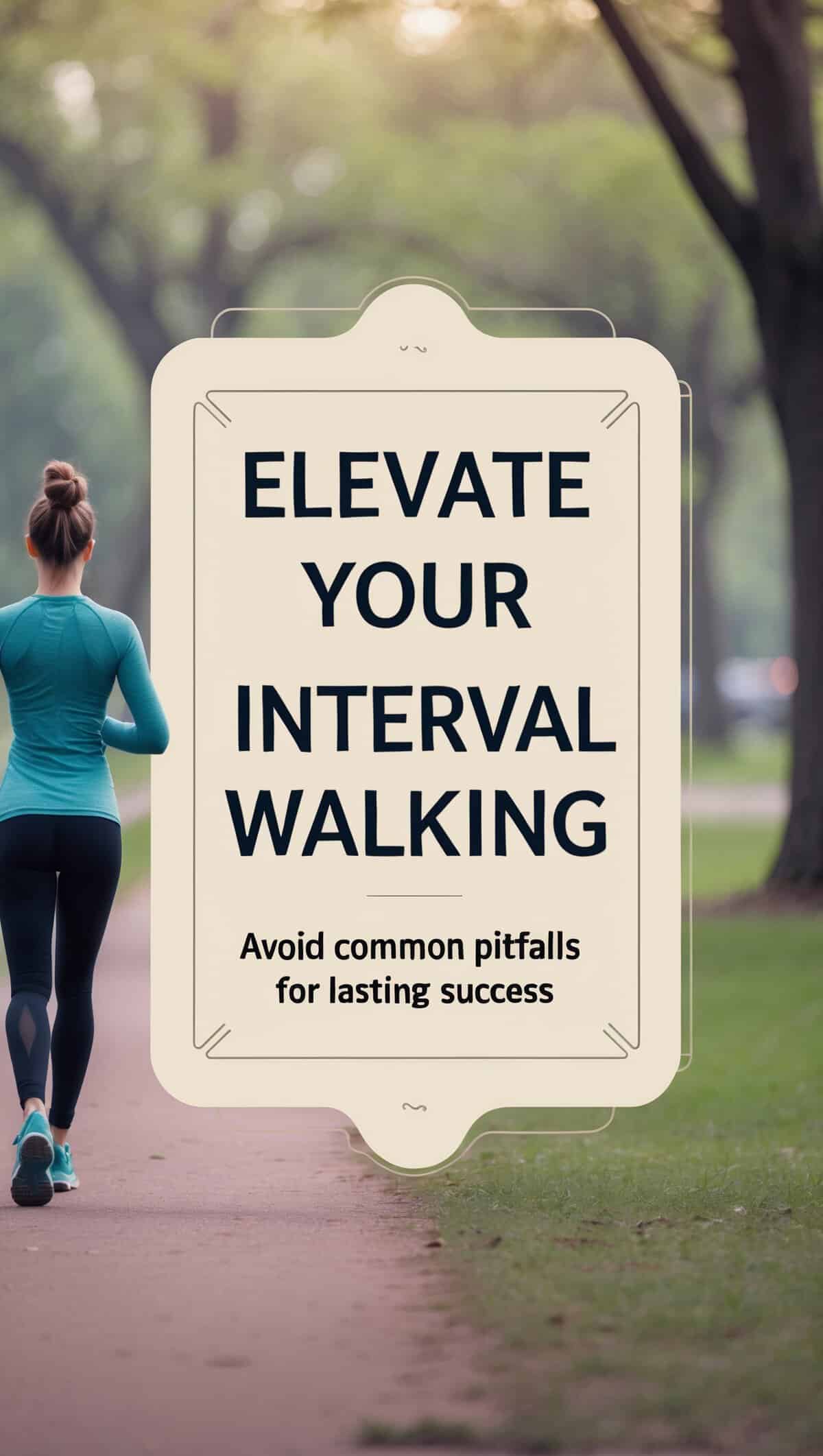
Interval walking journeys often include avoidable pitfalls that can slow progress and diminish results. The most common mistake is inconsistent intensity—either pushing too hard during high-intensity intervals (making the workout unsustainable) or not challenging yourself enough (limiting metabolic benefits). Effective interval walking requires genuine contrast between work and recovery periods. Your high-intensity intervals should bring you to about 7-8 out of 10 on the effort scale, where speaking in full sentences becomes difficult but not impossible. If you can chat comfortably, you’re not pushing hard enough; if you can’t speak at all, you may be pushing too hard for sustainable progress.
Another mistake that undermines results is neglecting progression. Many people establish a comfortable routine and stick with it indefinitely, missing the fundamental principle that drives continued improvements: progressive overload. The body brilliantly adapts to whatever stress is placed on it, so without systematic progression (whether through intensity, duration, or interval structure), results inevitably plateau. The key is planned, incremental changes—perhaps reducing recovery time by 5-10 seconds every two weeks, or adding one additional interval to each set. These small adjustments prevent plateaus while maintaining the sustainability that makes interval walking such an effective long-term strategy for weight loss.
Form Failures
Walking with poor posture, insufficient arm movement, or improper foot strike reduces effectiveness and increases injury risk.
Nutrition Negation
Unconsciously increasing caloric intake in response to increased hunger (or as “reward” for exercise) can completely offset the caloric deficit from interval walking.
Recovery Reluctance
Failing to build appropriate rest days and proper sleep into your program leads to diminished results and increased injury risk.
How to Avoid the Common Pitfalls
- Use objective measures of intensity (heart rate, pace, or the talk test) rather than subjective feelings
- Keep a simple training log to ensure you’re progressively modifying one variable at a time
- Schedule regular “technique check” sessions where you focus primarily on form and proper walking mechanics
- Plan recovery nutrition in advance to avoid impulsive, counterproductive choices after workouts
- Balance intensity with adequate recovery by incorporating at least 2-3 non-interval days weekly
Picture This
You’re executing your interval walking session with the wisdom that comes from avoiding common mistakes. Your form is impeccable—shoulders relaxed, core engaged, feet striking properly with each step. You’re monitoring your intensity with precision, pushing just hard enough during high-intensity intervals to create the optimal training stimulus without overreaching. Your workout is part of a thoughtfully designed progression that continues challenging your body appropriately as your fitness improves. Each element of your interval walking practice—from session structure to recovery strategies—is aligned with proven principles, creating a sustainable approach that continues delivering weight loss results while keeping you injury-free and motivated.
Want to Simplify Your Wellness Journey?
As you’ve learned throughout this article, interval walking offers powerful benefits for weight loss, but it’s just one piece of a successful and sustainable transformation. Creating lasting results requires a personalized approach that integrates proper nutrition, recovery strategies, progression planning, and consistency—all tailored to your unique body and lifestyle.

Ready for a Customized Approach to Your Wellness Journey?
My Wellness Lifestyle Strong Foundation Consultation helps you cut through the confusion and create a comprehensive strategy that works specifically for you. During this 90-minute audit session, we’ll assess your current habits, identify your unique needs, and develop a practical plan that may include interval walking alongside other evidence-based approaches for sustainable weight loss.
You’ll receive a personalized blueprint that addresses not just exercise, but all the critical elements that support your success—from nutrition timing to progress tracking methods that keep you motivated. Skip the frustrating cycle of trial and error and start your journey with clarity and confidence. Book your Wellness Lifestyle Strong Foundation Audit today and transform your approach to lasting wellness!
Personalized Wellness Plan Development

Final Thoughts
Interval walking truly represents the sweet spot for sustainable weight loss—challenging enough to create meaningful physiological change yet gentle enough to maintain for the long term. Throughout this guide, we’ve explored how strategically alternating between higher and lower intensities creates a metabolic environment that conventional walking simply cannot match. From the science of EPOC to practical implementation strategies, interval walking offers a comprehensive approach that continues delivering results long after steady-state cardio has stalled.
What makes interval walking particularly powerful is its scalability. Whether you’re just beginning your fitness journey or looking to break through a frustrating plateau, the fundamental principles remain the same—only the specific implementation changes.
The key to success lies in embracing the process rather than fixating solely on outcomes. Each interval walking session represents progress, regardless of what the scale shows that day.
If you take only one thing from this guide, let it be this: consistency trumps perfection. The interval walking program you can maintain for months will always outperform the “perfect” program you abandon after two weeks. Start where you are, progress at a pace that feels sustainable, and trust that the cumulative effect of these strategically structured sessions will create the changes you’re seeking.
I encourage you to begin your interval walking journey today, even if that means just five minutes of gentle work/recovery cycles. Your future self will thank you not just for the weight loss results but for the increased energy, improved mood, and enhanced quality of life that comes with this approach to movement.
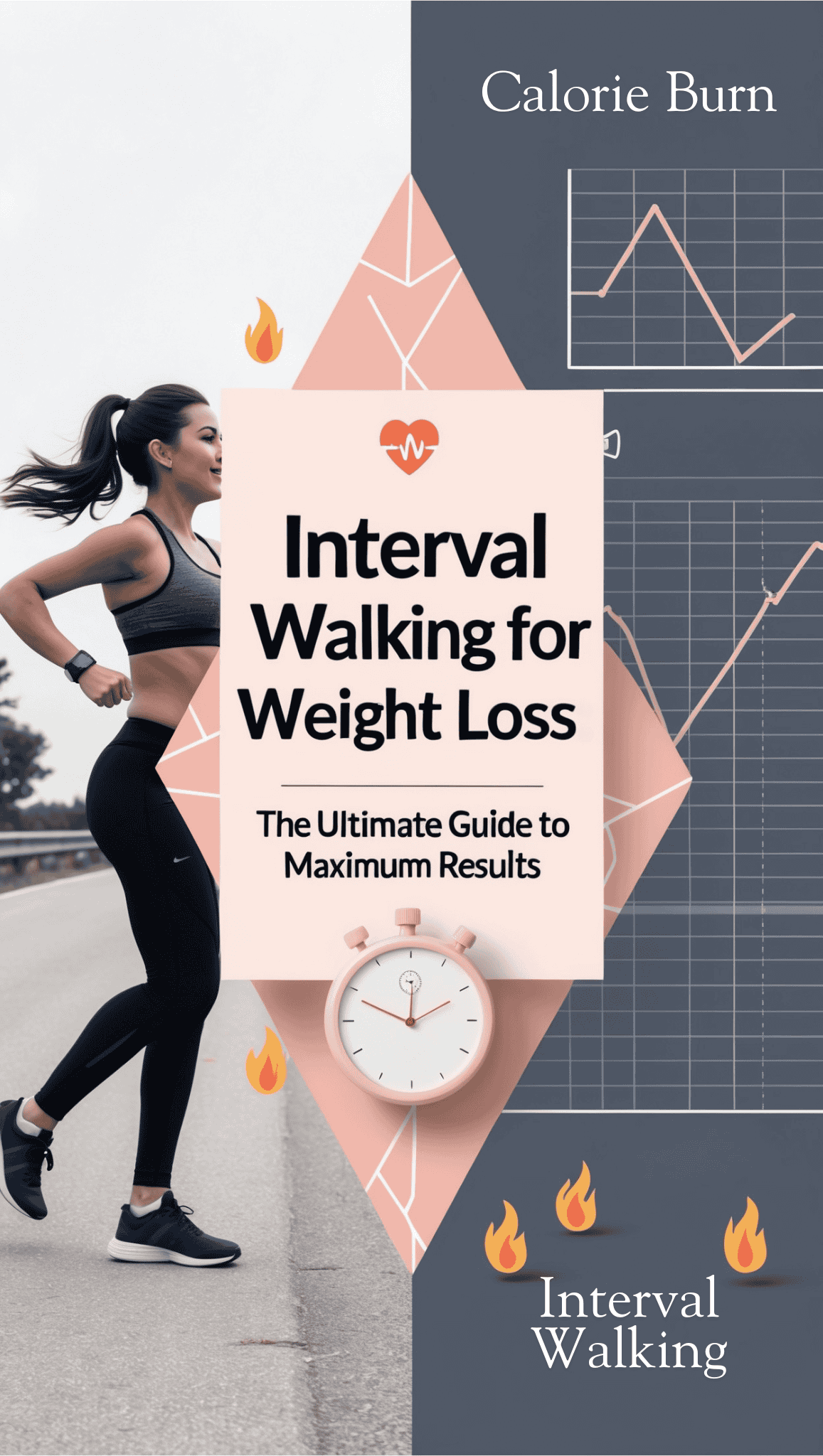
This post may contain affiliate links. I only recommend products and services I genuinely believe in. Additionally, some images on this website may have been created with the help of AI to convey the feeling I wish to share with the reader.
Frequently Asked Questions
How quickly will I see weight loss results from interval walking?
Most people begin noticing changes within 2-4 weeks of consistent interval walking, though initial changes may be more evident in measurements and energy levels than on the scale. Individual results vary based on several factors including starting fitness level, nutrition, sleep quality, and stress levels. For optimal results, aim for 3-4 interval walking sessions weekly combined with supportive nutrition practices and adequate recovery. Remember that sustainable weight loss typically occurs at a rate of 1-2 pounds per week, and interval walking creates the metabolic environment to support this healthy progression when part of a comprehensive approach.
Can I do interval walking every day?
While daily movement is generally beneficial, daily interval walking isn’t recommended for most people due to the recovery demands of high-intensity exercise. The metabolic benefits of interval walking come partly from the body’s recovery response, which requires adequate rest between sessions. Most research suggests 3-4 interval sessions weekly provides optimal results while minimizing overtraining risk. On non-interval days, consider light activity like traditional walking, gentle yoga, or other low-intensity movement that supports recovery while maintaining activity levels. Listen to your body—persistent fatigue, decreased performance, or increased soreness suggests you need more recovery time between interval sessions.
Is interval walking safe for people with joint problems?
Interval walking can actually be safer than running or jogging for those with joint concerns, as it maintains ground contact and reduces impact forces. However, proper progression is essential—begin with very modest intensity increases and longer recovery periods, gradually building as your body adapts. Proper footwear with adequate cushioning and support is particularly important for those with joint sensitivity. Consider starting on softer surfaces like grass, dirt paths, or even specialized cushioned tracks before progressing to harder surfaces. For those with significant joint issues, consulting with a physical therapist or sports medicine physician before beginning an interval walking program is advisable to develop modifications specific to your condition.
What should I eat before and after interval walking for maximum weight loss?
Pre-workout nutrition should be based on timing—if walking within 30-60 minutes of waking, many people find fasted interval walking effective for fat burning, though this is individual. For later sessions, a small snack with easily digestible carbohydrates and some protein (like half a banana with a tablespoon of nut butter) 30-45 minutes beforehand can provide energy without digestive discomfort. Post-workout nutrition is particularly important—aim to consume a combination of protein and carbohydrates within 45 minutes of completing your session to support recovery and metabolic health. Focus on whole food sources like smoothies with protein, fruit and vegetables, or Greek yogurt with berries and a small amount of granola.
How can I stay motivated with my interval walking program?
Sustainability comes from finding genuine enjoyment in the process rather than focusing exclusively on outcomes. Many successful interval walkers report that the varied nature of intervals helps maintain interest compared to steady-state walking. Try incorporating entertainment like podcasts or audiobooks during recovery intervals (while staying mindful during high-intensity periods). Consider social accountability through walking partners, online communities, or tracking apps that provide progress metrics beyond weight. Set process-based goals (completing a certain number of sessions weekly) rather than outcome-based goals (losing X pounds), and celebrate these achievements. Finally, experiment with different locations, interval patterns, an
About The Author
Jahlila is a Transformational Whole Self and Wellness Lifestyle Empowerment Coach, a devoted mother, passionate writer, and a fervent advocate for holistic wellness. She is the creator of The Tri-Sync Method, a comprehensive coaching program designed to help women establish a personalized wellness and self-care lifestyle for enduring total health wellness.
Her journey has transitioned from focusing solely on health and fitness to embracing a broader mission: empowering women through holistic approaches that unite body, mind, and spirit. Jahlila is dedicated to teaching, coaching, writing, and speaking about how wellness intersects with a joyful, balanced life. Her mission is to motivate women to prioritize and achieve their wellness goals, fostering a deep connection between a vibrant lifestyle and true happiness. Ready to reclaim your vitality, achieve mental clarity, and embrace your wellness journey? Explore more at The Tri-Sync Method.Com
Don’t wait another day to start living your healthiest, happiest life. Schedule a Free Discovery Consultation with Jahlila today to explore how The Tri-Sync Method can transform your life. For additional questions or personalized guidance, please visit our Contact Page.




Leave a Reply